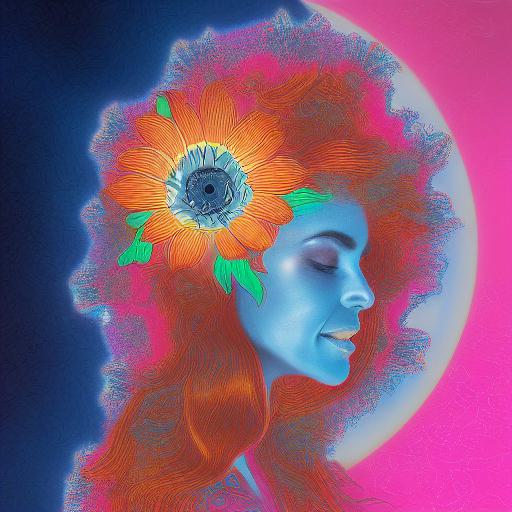How to write this prompt?
Here’s a breakdown of the AI image prompt you provided, explaining each individual part and how it can influence the image being generated:
- Description: “A digital Psychedelic painting inspired by Amanda Sage, Artstation contest winner”
- This sets the style and theme of the artwork, indicating that it should have a psychedelic and digital painting aesthetic similar to the works of Amanda Sage, who won an Artstation contest. It implies that the resulting image should incorporate abstract and vibrant elements.
- Subject: “featuring a woman with a laughing flower in her hand”
- This specifies the main subject of the image, which is a woman holding a laughing flower. It suggests that the generated image should include a female figure and a visually distinctive flower that conveys a sense of joy and humor.
- Color Palette: “predominantly sky blue and navy blue with some silver and white accents”
- This defines the color scheme for the image, emphasizing shades of sky blue and navy blue. It also includes silver and white accents. These colors should dominate the overall composition, with the silver and white acting as complementary or highlighting tones.
- Camera Angle: “a low angle view, giving a sense of power and dominance”
- This determines the perspective from which the scene is depicted. A low angle view implies that the viewer is looking up at the subject, creating a sense of power and dominance. The generated image should be framed from this perspective to convey a particular mood.
- Lighting: “a mixture of dramatic and dark lighting, giving a moody and mysterious feel”
- This describes the lighting style desired for the image. It should combine elements of dramatic lighting, which can create high contrasts between light and shadow, with an overall dark tone. This lighting choice sets a moody and mysterious atmosphere for the generated artwork.
By providing such detailed instructions in the prompt, the AI model can understand and interpret the desired elements accurately. This helps ensure that the generated image aligns with the intended artistic direction, incorporating the specific style, subject, color palette, camera angle, and lighting effects outlined in the prompt.
What is the significance of using a low angle view in a painting or artwork?
Using a low angle view in a painting or artwork can evoke a sense of power, dominance, or grandeur. It creates a dynamic composition by placing the viewer in a position of looking up at the subject, making the subject appear larger or more imposing. This perspective can add drama and impact to the overall image, influencing the viewer’s emotional response.
How to create a psychedelic effect in a digital painting?
To create a psychedelic effect in a digital painting, you can employ various techniques. Start by using vibrant and contrasting colors, often with surreal or abstract elements. Experiment with patterns, distortions, and unconventional compositions. Incorporate organic shapes, flowing lines, and intricate details. Apply visual effects such as motion blur, glowing highlights, or color gradients. Overall, embrace a sense of imagination, playfulness, and exploration to achieve the desired psychedelic atmosphere.
Why is lighting important in setting the mood of an artwork?
Lighting plays a crucial role in setting the mood of an artwork because it directly affects how the subject and surrounding elements are perceived. Different lighting conditions can evoke specific emotions and create varying atmospheres. For example, dramatic lighting with strong contrasts can convey a sense of mystery, tension, or intensity. Soft, diffused lighting may evoke tranquility or serenity. By carefully controlling the lighting, artists can enhance the narrative, evoke specific feelings, and guide the viewer’s focus within the artwork.
Can AI art generation prompts be used for educational purposes?
Yes, AI art generation prompts can be valuable for educational purposes. They can be used to teach students about various artistic styles, techniques, and concepts. By providing detailed prompts, educators can guide students in understanding and replicating specific artistic elements. AI-generated prompts can also spark creativity and serve as a starting point for students to explore their own artistic interpretations. Additionally, studying AI-generated art can foster discussions about the intersection of technology, creativity, and ethics, encouraging critical thinking and reflection.
How can AI-generated art be used to inspire or inform other forms of creative expression?
AI-generated art can serve as a powerful source of inspiration for other forms of creative expression. Artists can analyze and study the unique visual elements, compositions, and styles generated by AI models, using them as references or stepping stones for their own work. AI-generated art can introduce new possibilities and push the boundaries of traditional artistic approaches. It can also inform artists about emerging trends and novel techniques, providing fresh perspectives on the intersection of technology and creativity. Additionally, AI-generated art can be used collaboratively with human artists, acting as a tool or medium to enhance their creative process and output.
Looking to add some cutting-edge creativity to your designs? Look no further than Visual Paradigm Online! With our innovative design tools, you can seamlessly incorporate stunning AI-generated art into your graphics with just a few clicks. Our user-friendly interface and extensive range of design templates and assets make experimentation a breeze, so you can explore countless styles and layouts until you find the perfect combination for your project. Elevate your designs to the next level with Visual Paradigm Online today!


